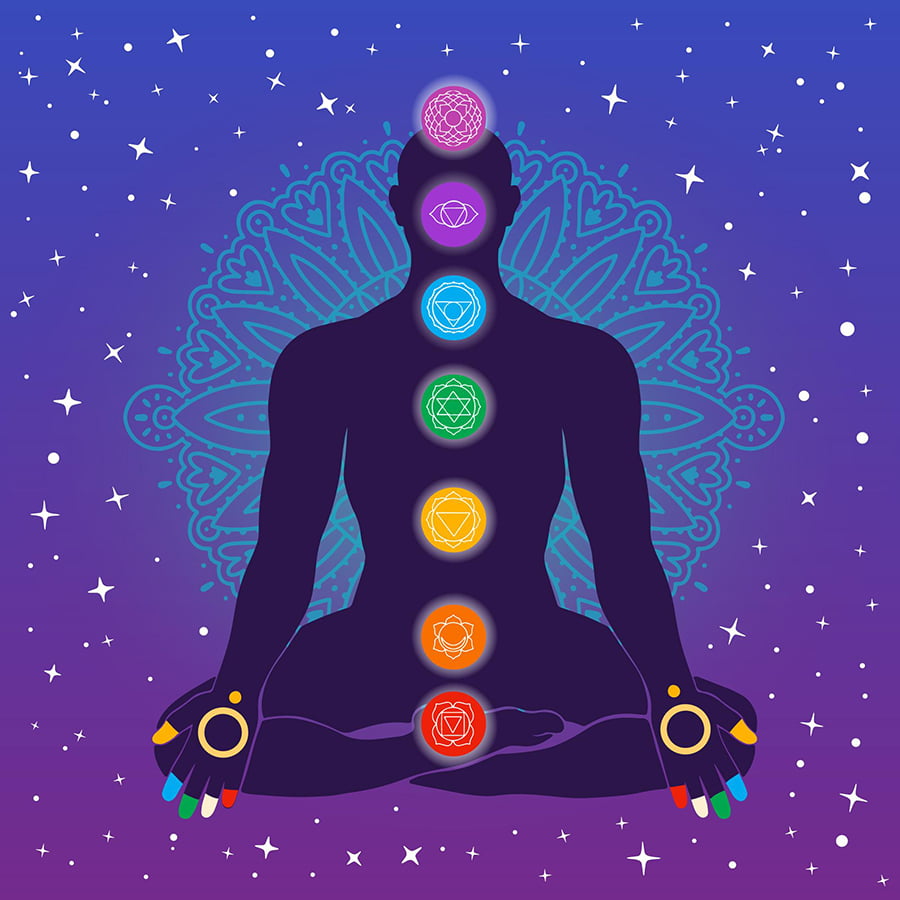Finding your personal mantra for transcendental meditation is crucial because it tunes into your specific energy frequency, thus fostering deeper levels of relaxation and mental clarity.
Embarking on the journey of transcendental meditation is a transformative experience, and finding your personal mantra is a crucial part of this process. This unique sound or phrase, when silently repeated during meditation, can help you transcend the surface level of conscious thoughts, leading to a state of deep relaxation and inner peace.
Your personal mantra is like a key that opens the door to your inner self, and finding the right one for you is a process that requires self-reflection, understanding, and a bit of guidance. This article will provide you with a comprehensive guide on how to find your mantra for transcendental meditation, ensuring you have all the necessary information to make this spiritual journey a successful one.
Key takeaways:
- Your personal mantra is like a key that opens the door to your inner self.
- Transcendental Meditation is simple and requires no specific postures or tools.
- Choose a mantra that feels calming and resonates with you.
- Practice regularly for 15-20 minutes twice daily for optimal benefits.
- Mantras in Transcendental Meditation enhance focus and reduce stress.
Origins Of Transcendental Meditation

Traced back to India around 5,000 years ago, this ancient practice formed an integral part of the Vedic tradition. Known for its roots in Hindu philosophy, it was popularized worldwide in the 1960s by Maharishi Mahesh Yogi.
This deep-seated practice leverages natural processes to allow the mind to settle inward, beyond thought, targeting a silent, profound state of restful alertness. Designed to exceed ordinary states of awareness, it thrives on the exploration of the self, expanding individual consciousness and encouraging personal growth.
This technique, marked by the use of a mantra, provides an avenue to effortlessly transcend the surface level of thought and experience the quietest, most peaceful level of consciousness, also known as “transcendental consciousness” or “pure awareness“.
Understanding Transcendental Meditation

Transcendental Meditation, distinct from guided visualizations or affirmations, invites practitioners to sit comfortably, close their eyes, and silently repeat a specific mantra. This mantra, a “vehicle of the mind”, allows for inward-focused thought and encourages relaxation, rest, a strong immune system, and increased creativity.
Unlike other forms of meditation that assign significance to certain words, the simplicity of a mantra in Transcendental Meditation carries little meaning but significant rhythmic sound. Its aim is not to instill new thoughts, but instead to transcend all thought, reaching a state of pure consciousness.
Effectively practiced for 15-20 minutes twice daily, this form of meditation is renowned for reducing stress and anxiety. Here are key points for considering:
- Simple Practice: No specific postures or tools, a quiet place, and a comfortable seat is all you need.
- Individuality: Mantras are selected based on the practitioner’s age and sometimes gender.
- Quiet: The mantra is repeated silently, and it’s perfect to keep inner noise at bay.
- Restful Alertness: The goal isn’t sleep but a state of restful alertness, where the mind is awakened restfully.
- Natural: No forced concentration necessary as it follows the mind’s natural inclination towards greater satisfaction.
These points underscore the simplicity and beauty of Transcendental Meditation. A personal moment of silence every day inhabits lifelong benefits.
The Technique of Transcendental Meditation

Rooted in ancient traditions, the technique of Transcendental Meditation involves twice-a-day sessions of 20 minutes each, ideally practiced in a quiet and comfortable place. Unlike other forms of meditation, it doesn’t involve concentration, control of the mind or focus on breathing or chanting. Instead, it encourages a restful state of mind.
Here are some essential points that detail this technique:
- Comfort is paramount: Choose a cozy, distraction-free space. Your posture should be upright, typically seated, but the key is to be relaxed.
- No striving: There’s no need to force concentration or manipulate the mind in any way. The goal isn’t to eliminate thoughts but to allow them to flow spontaneously.
- Use of a mantra: A personal mantra, silently repeated to oneself, helps to guide the mind beyond the surface level of consciousness gently.
- Effortless practice: The transition to a meditative state occurs naturally, not by enforcing will or effort. Let the process unfold without seeking specific outcomes.
- Twice daily habit: Ideally, practice in the morning before breakfast and in the evening before dinner for maximal benefits.
- Guidance matters: Learning from certified Transcendental Meditation teachers can ensure correct practice and provide support for any questions or issues that may arise.
How Transcendental Meditation Differs From Other Techniques

In terms of technique, Transcendental Meditation is unique due to its natural, effortless approach. While many meditation practices require concentration or visualization, TM simply involves the silent internal chanting of a mantra, allowing the mind to drift into a state of relaxed awareness.
1. Effortless Practice: Unlike focused attention or mindfulness, TM promotes a restful state of the mind without straining or actively attempting to quell thoughts.
2. Use of Mantras: Transcendental Meditation utilizes specific words or sounds, known as mantras. This anchors the process and allows the mind to settle into silence.
3. Personal and Individualized Experience: Every practitioner in transcendental meditation is provided with a unique, personalized mantra which suits their characteristics and lifestyle.
4. Sessions and Duration: Typically, TM is practiced for 20 minutes, twice a day- once in the morning and once in the evening, providing flexibility to fit into any routine.
5. Trained Guidance: One does not simply learn TM online or from a book, it often involves a certified teacher to ensure proper practice.
Understanding these nuances helps to appreciate the uniqueness of Transcendental Meditation and its departure from other mainstream meditation techniques.
Choosing the Right Transcendental Mantras for Meditation

A personal mantra is a key component in transcendental meditation. It should be a simple, unspecific sound that resonates with you and aids in settling your mind.
Traditionally, these mantras are given by a certified teacher, but the following steps can guide you if you choose your own mantra:
- Select a Non-Meaning Sound: These sounds do not carry a defined meaning to avoid creating any specific mental images that might distract during meditation.
- Consider Your Comfort: Choose a sound that feels calming and doesn’t strain your voice or create unease.
- Resonance over Complexity: A simple, resonant sound is more effective than a complex one as it allows easy repetition.
- Respect Cultural Sensitivities: If choosing from established mantras, ensure it does not offend or misappropriate any cultural beliefs or practices.
- Ensure Privacy: Your personal mantra is unique to you and is meant to be kept private for maintaining its efficacy.
Choosing a mantra is about connecting to a sound that brings you inner peace, so give thought and connect with your intuition during the selection process.
How to Use Transcendental Meditation Mantras

To incorporate mantras in your transcendent meditation practice, follow these simple steps:
1. Choose a Quiet Place: It’s important to identify a calm environment where you won’t be disturbed during your meditation.
2. Position Yourself Comfortably: You can sit, lie down, or remain in any stable position. Keep your back straight and relaxed to facilitate easy breathing.
3. Close Your Eyes: This will help to concentrate deeply and stimulate relaxation, minimizing external distractions.
4. Repeat Your Mantra: Silently repeat your chosen mantra without moving your tongue or lips. It’s about ‘thinking’ the mantra in your inner voice.
5. Don’t Force It: Don’t attempt to speed up the process or force the mantra. Allow it to arise naturally like a faint thought in the background.
6. When Mind Wanders, Gently Return to the Mantra: It’s common for thoughts to wander, especially as a beginner. Each time you notice this, gently bring your attention back to your mantra.
7. Practice Regularly: Apply this technique daily, ideally, once in the morning and once in the evening for best results.
Remember, the mantra is not a word to be pronounced loudly but to be ‘heard’ or ‘thought’ in a quiet, relaxed state of consciousness. This aids in going beyond surface-level thoughts and allows for a deeper, fulfilling meditation experience.
Importance of Beeja Mantras in TM Meditation

Beeja, or ‘seed’, mantras hold a substantial place in Transcendental Meditation. Based on ancient Vedic traditions, these non-semantical sounds target the deeper levels of the mind, fostering a state of profound tranquility.
Here are a few valuable insights into their role:
1. Unlocks Deep Reserves: Think of these Beeja mantras as keys, each unlocking a different area of the subconscious mind. Their vibrational frequencies resonate with various regions, subtly guiding the mind into the peaceful state of transcendental consciousness.
2. Harmonizes Mind and Body: The vibrations from chanting these mantras promote an integrative resonance, effectively harmonizing the physiological and mental states. This cultivates a unified, whole body experience that enhances mental clarity.
3. A Guard Against Distractions: By establishing a focus on these seed sounds, distractions become easier to manage. Mantras act as a smooth sail, guiding the mind away from the undercurrents of daily thoughts, helping to secure a deeper meditative state.
4. Emotional Cultivation: Traditionally, Beeja mantras have been known to evoke specific qualities such as happiness, creativity, or inner peace. Their chant aids in fostering these emotional states, nourishing inner growth.
5. Unique Personal Experience: No two people have the same reaction to a mantra. Each person’s experience with a specific Beeja mantra is unique, making your meditation journey a singular, deeply personal one.
Benefits of Using Mantras in Transcendental Meditation

Mantras in Transcendental Meditation serve as a vehicle to deeper levels of consciousness. Here are a few benefits they provide:
- 1. Fostering Concentration: The repetition of a mantra allows the mind to focus, aiding in the reduction of random thoughts.
- 2. Stress Reduction: By naturally drawing the attention inward, mantras minimize stress, leading to improved health and well-being.
- 3. Enhanced Self-Awareness: Regular use of mantra helps to cultivate a greater awareness of one’s mental and emotional experience.
- 4. Generation of Positive Energy: The vibrations from a mantra can help create a positive energy field around the mediator.
- 5. Facilitation of Transcendence: The repeated, rhythmical sounding of a mantra provides a medium to transcend to deeper layers of consciousness.
- 6. Promotes Emotional Balance: Chanting of mantras can help balance emotions, contributing to a sense of peace and tranquility.
Mantras are more than mere repetition of sounds. Their use within Transcendental Meditation is a profound tool for personal transformation and self-discovery.
Oldest Known Transcendental Meditation Mantras

Dating back several thousands of years, these ancient words of wisdom were initially used in Hindu and Buddhist practices. With time, they’ve been incorporated into Transcendental Meditation.
1. Om: Despite its simplicity, Om is incredibly powerful. When chanted, it creates vibrations that resonate with the universal energy and helps to focus the mind.
2. Soham: This mantra literally translates to “I am that,” promoting self-realization and a deep connection with the universe. Soham aligns our personal consciousness with universal consciousness.
3. Sat Nam: Used widely in Kundalini yoga, this mantra means “Truth is my identity.” It encourages the practitioners to find and live their truth.
4. Aham Prema: This means “I am divine love.” Chanting this mantra focuses on embracing self-love and nurturing compassion towards ourselves and others.
Though they are old, these mantras retain their deep spiritual significance. Their synergistic relationship with Transcendental Meditation allows practitioners to tap into an ancient stream of consciousness, attaining a profound inner peace.
Transcendental Meditation Mantras Categorized By Age Group

Every individual possesses a unique energy based on their age, which correlates directly with specific sound vibrations. It is important to align these energies and vibrations while choosing a mantra in Transcendental Meditation.
1. For those under 10: Simplicity reigns. Mantras for this age group are short, sweet, and kinetic, appealing to youngsters’ vibrant energy, such as “Ing” or “Aim.”
2. Age 10-20: The vitality and spontaneity of adolescence get mirrored in slightly complex mantras that reflect growth, like “Im” or “Aing.”
3. Age 20-30: During this formative epoch in life, the mantras assume an empowering turn, with sounds like “Shiring” or “Shrim.”
4. Age 30-40: As stability and maturity start setting in, the mantra introduces a grounding factor with sounds such as “Shama” or “I’m.”
5. Above 40: At this age, the focus is on peace, wisdom, and acceptance, captured in calming and spiritual mantras like “Shanti” or “Soham.”
Remember, within each category, gender differentiation is also observed. For example, “Shiring” is preferred for young women, while “Shiringa” is for young men. This subtle switch in sound vibration caters to gender-specific energies, providing a personalized meditation experience.
Transcendental Meditation Mantra Sounds Differ By Gender

In traditional transcendental meditation practice, men and women are often assigned different sets of mantras. These mantras, also known as Beeja or seed mantras, are often derived from Sanskrit sounds believed to hold specific vibrational qualities.
1. The mantras vary depending on both the individual’s age and gender. This practice bases the variations on the belief that every life stage resonates a distinct energy pattern.
2. Male mantras often have hard consonants and stronger sounds reflecting, traditionally, the masculine energy that is often associated with the sun, fire, and other forces of power.
3. Feminine mantras, on the other hand, typically consist of softer, more soothing sounds. They are meant to embody the female energy often linked with the moon, water and healing forces.
In the realm of transcendental meditation, the specific sound or vibration of a mantra is tied deeply to the individual’s consciousness, so finding the right fit is key. Remember, these choices are traditional and not mandatory. Your comfort and connection with your mantra is always paramount.
The Role of Mantras in Transcendental Meditation

In Transcendental Meditation, a mantra isn’t just a word but a tool, and a key technique that guides the mind to dive inward, past the realm of thoughts and emotions, towards deep silence. These mantras, called Beeja, vibrate at frequencies that promote tranquility and clarity, making it easier to engage in meditative practice.
By focusing on a mantra during TM, we latch onto a consistent pattern that anchors consciousness and reduces mental chatter. This focus on a chosen mantra helps to bypass distractions, calms the active mind, and initiates a process of introspection or self-transcendence, hence the term ‘Transcendental Meditation‘.
Further, mantras serve as guiding signals in the meditation process, and when accurately selected and employed, they can assist in cultivating a mind that is alert, calm, and profoundly in the present. A mantra is a personal choice, and it’s crucial to choose one that resonates with you for optimal benefits. Ensuring a connection with your mantra guarantees a more effortless, enriching practice.
Although the use of mantras in TM can seem like a simple activity, it’s indeed a profound method that nurtures a bridge between our outwardly focused mind and the innermost self, promoting an overall sense of balance and calm.
What to Expect During Transcendental Meditation Practice

As you embark on this journey, you’ll initially notice a sense of relaxation cascading over you. This is your mind beginning to enter a state of profound tranquility.
As the meditation continues, your mantra will subtly guide your consciousness toward the deepest reservoirs of peace, creativity, and clarity. You’ll be aware of your breathing becoming softer, and may perhaps recognize faint sensations or thoughts in your periphery. But, remember, nothing must distract you – gently nudge your focus back to the mantra whenever necessary.
Further into the practice, the mantra may fade or be experienced more delicately, or even disappear entirely. This is normal. It’s valuable to remember your personal mantra is more like a tool, rather than a strict dictum. Even though you may wander away from it during your sessions, it’s fine to take it up when you notice you’re getting lost in thoughts.
Lastly, don’t work hard. Transcendental Meditation is a process that unfolds with effortlessness. There’s no wrong way to meditate. Each experience is unique, and however you feel is the most effective way for you personally. You may feel like you’re barely scratching the surface one day and plunge deep into tranquillity the next. All of these are enriching steps in your TM journey.
FAQ
How do I find my meditation mantra?
To find your meditation mantra, you should consider asking yourself what you need and explore various phrases that resonate with your inner truth.
How do you identify a mantra?
A mantra is identified as a repeated word or phrase used in meditation to evoke positive, transformative energy, and can range from one syllable to the length of a paragraph.
What is my personal mantra?
Your personal mantra is a positive phrase or affirmative statement that you recite to yourself for motivation and encouragement.
Can you do Transcendental Meditation without a mantra?
No, you cannot do Transcendental Meditation without a mantra as the technique relies on the silent repetition of a given mantra to achieve focus and depth of meditation.
What are the benefits of having a personalized meditation mantra?
A personalized meditation mantra can enhance focus, reduce stress, and promote a deeper connection with one’s self by providing a specific, meaningful focal point during meditative practices.
How does a personalized mantra enhance the transcendental meditation experience?
A personalized mantra in transcendental meditation amplifies the experience by promoting deeper focus, reducing distractions, and fostering a more profound connection between mind and body.
What are some effective strategies for cultivating a meditation mantra that resonates with me?
An effective strategy is to identify a simple, short, positive phrase that deeply resonates with your aspirations or intentions during your meditation practice.